Contents
NCERT Solutions for 8th Class Maths: Chapter 10-Visualising Solid Shapes
Page No: 157
Exercise 10.1
1. For each of the given solid, the two views are given. Match for each solid the corresponding top and front views. The first one is done for you.
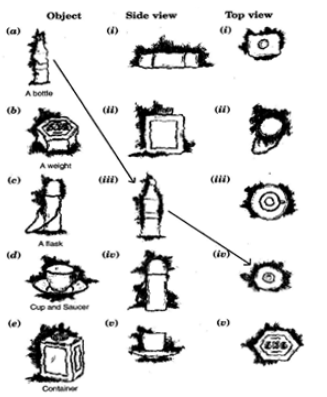
Answer
(a) → (iii) → (iv)
(b) → (i) → (v)
(c) → (iv) → (ii)
(d) → (v) → (iii)
(e) → (ii) → (i)
2. For each of the given solid, the three views are given. Identify for each solid the corresponding top, front and side views.


(a) (i) → Front
(ii) → Side
(iii) → Top view
(b) (i) → Side
(ii) → Front
(iii) → Top view
(c) (i) → Front
(ii) → Side
(iii) → Top view
(d) (i) → Front
(ii) → Side
(iii) → Top view
3. For each given solid, identify the top view, front view and side view.
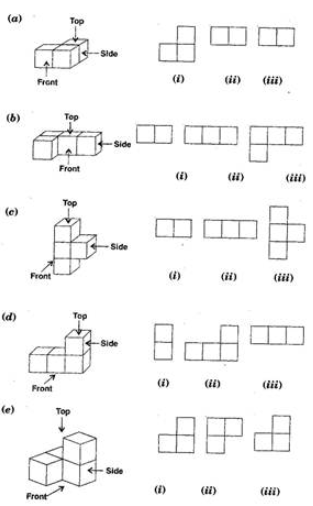
Answer
(ii) → Front view
(iii) → Side view
(b) (i) → Side view
(ii) → Front view
(iii) → Top view
(ii) → Side view
(iii) → Front view
(d) (i) → Side view
(ii) → Front view
(iii) → Top view
(ii) → Top view
4. Draw the front view, side view and top view of the given objects:

Answer
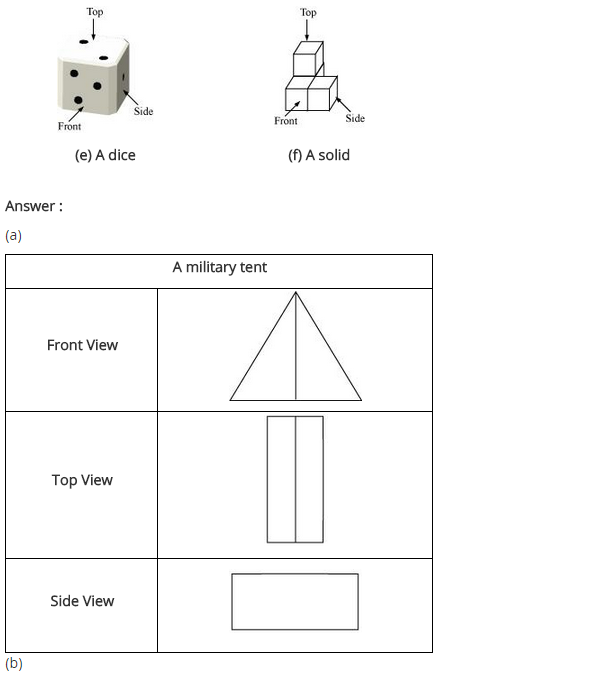
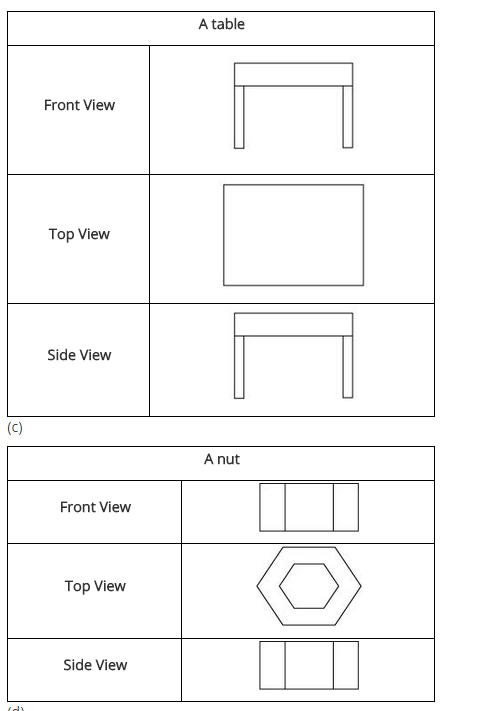
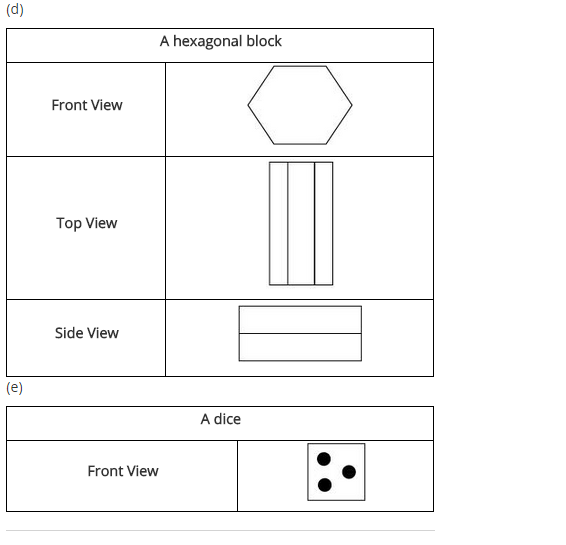
Page No. 163
Exercise 10.2
1. Look at the given map of a city.
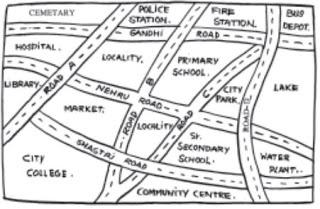
Answer the following.
(a) Colour the map as follows: Blue-water, red-fire station, orange-library, yellow – schools, Green – park, Pink – College, Purple – Hospital, Brown – Cemetery.
(b) Mark a green ‘X’ at the intersection of Road ‘C’ and Nehru Road, Green ‘Y’ at the intersection of Gandhi Road and Road A.
(c) In red, draw a short street route from Library to the bus depot.
(d) Which is further east, the city park or the market?
(e) Which is further south, the primary school or the Sr. Secondary School?
Answer
(a) The required map in colour is as follow:

(b) The marks can be put at the given point is indicated in the map in green X:
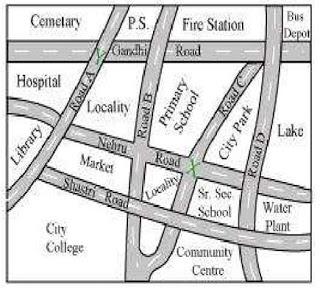
(c) The shortest route from library to the bus stop is indicated in the map in red colour:

(d) Between the market and the city park, the city park is further east.
(e) Between the primary school or the Sr. Secondary School, the Sr. Secondary School is further south.
Page No. 166
Exercise 10.3
1. Can a polygon have for its faces:
(i) 3 triangles
(ii) 4 triangles
(iii) a square and four triangles
Answer
(i) No, a polyhedron cannot have 3 triangles for its faces.
(ii) Yes, a polyhedron can have four triangles which is known as pyramid on triangular base.
(iii) Yes, a polyhedron has its faces a square and four triangles which makes a pyramid on square base.
2. Is it possible to have a polyhedron with any given number of faces? (Hint: Think of a pyramid)
Answer
It is possible, only if the number of faces are greater than or equal to 4.
3. Which are prisms among the following:
Answer
Figure (ii) unsharpened pencil and figure (iv) a box are prisms.
4. (i) How are prisms and cylinders alike?
(ii) How are pyramids and cones alike?
Answer
(i) A prism becomes a cylinder as the number of sides of its base becomes larger and larger.
(ii) A pyramid becomes a cone as the number of sides of its base becomes larger and larger.
5. Is a square prism same as a cube? Explain.
Answer
Yes, a square prism is same as a cube, it can also be called a cuboid. A cube and a square prism are both special types of a rectangular prism. A square is just a special type of rectangle! Cubes are rectangular prisms where all three dimensions (length, width and height) have the same measurement.
6. Verify Euler’s formula for these solids.

Answer
(i) Here, figure (i) contains 7 faces, 10 vertices and 15 edges.
Using Eucler’s formula, we see
F + V – E = 2
Putting F = 7, V = 10 and E = 15,
F + V – E = 2
⇒ 7 + 10 – 15 = 2
⇒ 17 – 15 = 2
⇒ 2 = 2
⇒ L.H.S. = R.H.S. Hence Eucler’s formula verified.
(ii) Here, figure (ii) contains 9 faces, 9 vertices and 16 edges.
Using Eucler’s formula, we see
F + V – E = 2
F + V – E = 2
9 + 9 – 16 = 2
⇒ 18 – 16 = 2
⇒ 2 = 2
⇒ L.H.S. = R.H.S.
Hence Eucler’s formula verified.
7. Using Euler’s formula, find the unknown:
| Faces | ? | 5 | 20 |
| Vertices | 6 | ? | 12 |
| Edges | 12 | 9 | ? |
Answer
In first column, F = ?, V = 6 and E = 12
Using Eucler’s formula, we see
F + V – E = 2
F + V – E = 2
⇒ F + 6 – 12 = 2
⇒ F – 6 = 2
⇒ F = 2 + 6 = 8
Hence there are 8 faces.
In second column, F = 5, V = ? and E = 9
Using Eucler’s formula, we see
F + V – E = 2
F + V – E = 2
⇒ 5 + V – 9 = 2
⇒ V – 4 = 2
⇒ V = 2 + 4 = 6
Hence there are 6 vertices.
In third column, F = 20, V = 12 and E = ?
Using Eucler’s formula, we see
F + V – E = 2
F + V – E = 2
⇒ 20 + 12 – E = 2
⇒ 32 – E = 2
⇒ E = 32 – 2 = 30
Hence there are 30 edges.
8. Can a polyhedron have 10 faces, 20 edges and 15 vertices?
Answer
If F = 10, V = 15 and E = 20.
Then, we know Using Eucler’s formula,
F + V – E = 2
L.H.S. = F + V – E
= 10 + 15 – 20
= 25 – 20
= 5
R.H.S. = 2
∵ L.H.S. ≠ R.H.S.
Therefore, it does not follow Eucler’s formula.
So polyhedron cannot have 10 faces, 20 edges and 15 vertices.
Chapterwise NCERT Solutions for 8th Class Maths
Chapter 1 – Rational Numbers
Chapter 2 – Linear Equations in One Variable
Chapter 3 – Understanding Quadrilaterals
Chapter 4 – Practical Geometry
Chapter 5 – Data Handling
Chapter 6 – Squares and Square Roots
Chapter 7 – Cubes and Cube Roots
Chapter 8 – Comparing Quantities
Chapter 9 – Algebraic Expressions and Identities
Chapter 10 – Visualizing Solid Shapes
Chapter 11 – Mensuration
Chapter 12 – Exponents and Powers
Chapter 13 – Direct and Inverse Proportions
Chapter 14 – Factorization
Chapter 15 – Introduction to Graphs
Chapter 16 – Playing with Numbers
About
The National Council of Educational Research and Training is an autonomous organization of the Government of India which was established in 1961 as a literary, scientific, and charitable Society under the Societies Registration Act. Its headquarters are located at Sri Aurbindo Marg in New Delhi. Visit the Official NCERT website to learn more.
